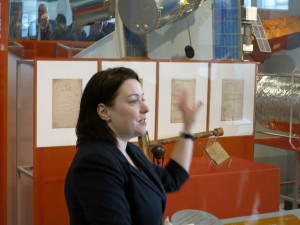January 21, 2016
History Group visit to the Science Museum, January 21, 2016
Alison Boyle
Report by: Mike Dryland
The Science Museum’s Cosmos & Culture was a ‘temporary’ exhibition opened in 2009 with the International Year of Astronomy to commemorate 400 years of telescopic astronomy. It has proved so popular that it’s still running in 2016 although scheduled to close before the end of the year.
Curator Alison Boyle, who is Keeper of Science Collections, very kindly arranged to meet us and show two groups of Flamsteed members round for a ‘last chance’ to see the exhibit.
The exhibition contains a host of milestone items from the history of astronomy and is divided into three large displays plus some large objects.
The entrance is dominated by Nasmyth’s 20-in reflecting telescope. Nasmyth was inventor of the steam hammer. On his retirement he built the telescope mounted at his home at Penshurst, Kent. He devised the “Nasmyth focus” which permits the eyepiece to be mounted at the pivot point of the telescope so the observer can stay seated in one place. Nasmyth was remarkable for his studies of lunar craters.
The first large display is called “Exploring the Cosmos” and contains telescopes and pieces of observing equipment starting with Harriot’s Moon drawings and a replica of one of Galileo’s first telescopes.
Ali talked about the huge metal mirror from Lord Rosse’s 48-in reflecting telescope at Birr Castle in Eire, and the Joint European X-ray Telescope (JET-X) space telescope suspended over the gallery.
The second display “Our place in the Cosmos” has celestial globes and other pieces of observing equipment.
Finally the third display is called “The Cosmos and Us” and has items from the application of astronomy to timekeeping, navigation, and hobbies.
In addition to Ali’s excellent tour, many of the group also visited the Cosmonauts special exhibition showing a wealth of items from the Soviet and Russian space programs. The exhibition is quite astounding and has objects never before seen outside Russia. Negotiating agreement for the exhibition to take place has taken many years. You have to be filled with admiration for the courage and skill of the early cosmonauts who flew in such simple equipment. Also included are items relating to Helen Sharman’s easily forgotten space flight. Helen was the first Briton to go into space on a Russian mission to the Mir space station in 1991 – 15 years before ‘Major Tim’s’ much-hyped flight to the ISS.
The visit was also an opportunity to look at the Clockmaker’s Museum in its new home at the Science Museum. The collection is beautifully displayed with about twice the space that was previously available in the Guildhall. It’s always a thrill to see the world’s second-best collection of Harrison pieces including early domestic regulators, H5, and the Jeffery’s watch.
A great day out!
Mike Dryland
Pictures from the Event (by Mike Dryland):
More pictures can be found here.
Posted under: Flamsteed, History of Astronomy, Meeting Report, Society Trip














You must be logged in to post a comment.